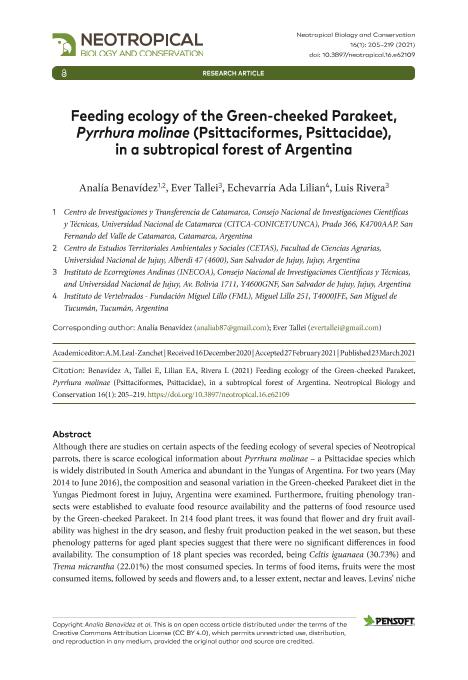Mostrar el registro sencillo del ítem
dc.contributor.author
Benavídez, Analía

dc.contributor.author
Tallei, Ever Denis

dc.contributor.author
Echevarria, Ada Lilian

dc.contributor.author
Rivera, Luis Osvaldo

dc.date.available
2022-08-23T14:50:39Z
dc.date.issued
2021-02
dc.identifier.citation
Benavídez, Analía; Tallei, Ever Denis; Echevarria, Ada Lilian; Rivera, Luis Osvaldo; Feeding ecology of the green-cheeked parakeet, pyrrhura molinae (Psittaciformes, psittacidae), in a subtropical forest of Argentina; Universidade do Vale do Rio dos Sinos; Neotropical Biology and Conservation; 16; 1; 2-2021; 205-219
dc.identifier.issn
2236-3777
dc.identifier.uri
http://hdl.handle.net/11336/166341
dc.description.abstract
Although there are studies on certain aspects of the feeding ecology of several species of Neotropical parrots, there is scarce ecological information about Pyrrhura molinae – a Psittacidae species which is widely distributed in South America and abundant in the Yungas of Argentina. For two years (May 2014 to June 2016), the composition and seasonal variation in the Green-cheeked Parakeet diet in the Yungas Piedmont forest in Jujuy, Argentina were examined. Furthermore, fruiting phenology transects were established to evaluate food resource availability and the patterns of food resource used by the Green-cheeked Parakeet. In 214 food plant trees, it was found that flower and dry fruit availability was highest in the dry season, and fleshy fruit production peaked in the wet season, but these phenology patterns for aged plant species suggest that there were no significant differences in food availability. The consumption of 18 plant species was recorded, being Celtis iguanaea (30.73%) and Trema micrantha (22.01%) the most consumed species. In terms of food items, fruits were the most consumed items, followed by seeds and flowers and, to a lesser extent, nectar and leaves. Levins’ niche breadth showed varying levels of diet specialisation amongst seasons, which was narrower (B = 0.28) in the wet season, indicating specialisation in diet during this season. There was a medium overlap in parakeet diet between seasons (Morisita Index = 0.59). We did not find a statistically significant relationship between resource availability and food use, but expansion and contraction in Levins Index and variation in food items consumed throughout the year and season demonstrate high flexibility in the diet. Like other congeners, the Green-cheeked Parakeet has a flexible diet that could be adjusted to the seasonal availability of food resources. These data may contribute to the design of conservation plans for the species and its habitat.
dc.format
application/pdf
dc.language.iso
eng
dc.publisher
Universidade do Vale do Rio dos Sinos
dc.rights
info:eu-repo/semantics/openAccess
dc.rights.uri
https://creativecommons.org/licenses/by/2.5/ar/
dc.subject
DIET
dc.subject
NICHE BREADTH
dc.subject
NON-PASSERINES
dc.subject
PIEDMONT FOREST
dc.subject
SEASONALITY
dc.subject
YUNGAS
dc.subject.classification
Ecología

dc.subject.classification
Ciencias Biológicas

dc.subject.classification
CIENCIAS NATURALES Y EXACTAS

dc.title
Feeding ecology of the green-cheeked parakeet, pyrrhura molinae (Psittaciformes, psittacidae), in a subtropical forest of Argentina
dc.type
info:eu-repo/semantics/article
dc.type
info:ar-repo/semantics/artículo
dc.type
info:eu-repo/semantics/publishedVersion
dc.date.updated
2022-08-23T11:08:54Z
dc.journal.volume
16
dc.journal.number
1
dc.journal.pagination
205-219
dc.journal.pais
Brasil

dc.journal.ciudad
São Leopoldo
dc.description.fil
Fil: Benavídez, Analía. Consejo Nacional de Investigaciones Científicas y Técnicas. Centro de Investigaciones y Transferencia de Catamarca. Universidad Nacional de Catamarca. Centro de Investigaciones y Transferencia de Catamarca; Argentina. Universidad Nacional de Jujuy. Facultad de Ciencias Agrarias. Centro de Estudios Ambientales Territoriales y Sociales; Argentina
dc.description.fil
Fil: Tallei, Ever Denis. Universidad Nacional de Jujuy. Instituto de Ecorregiones Andinas. Consejo Nacional de Investigaciones Científicas y Técnicas. Centro Científico Tecnológico Conicet - Salta. Instituto de Ecorregiones Andinas; Argentina
dc.description.fil
Fil: Echevarria, Ada Lilian. Fundacion Miguel Lillo. Direccion de Zoologia. Instituto de Vertebrados; Argentina
dc.description.fil
Fil: Rivera, Luis Osvaldo. Universidad Nacional de Jujuy. Instituto de Ecorregiones Andinas. Consejo Nacional de Investigaciones Científicas y Técnicas. Centro Científico Tecnológico Conicet - Salta. Instituto de Ecorregiones Andinas; Argentina
dc.journal.title
Neotropical Biology and Conservation
dc.relation.alternativeid
info:eu-repo/semantics/altIdentifier/url/https://neotropical.pensoft.net/article/62109/
dc.relation.alternativeid
info:eu-repo/semantics/altIdentifier/doi/http://dx.doi.org/10.3897/neotropical.16.e62109
Archivos asociados
